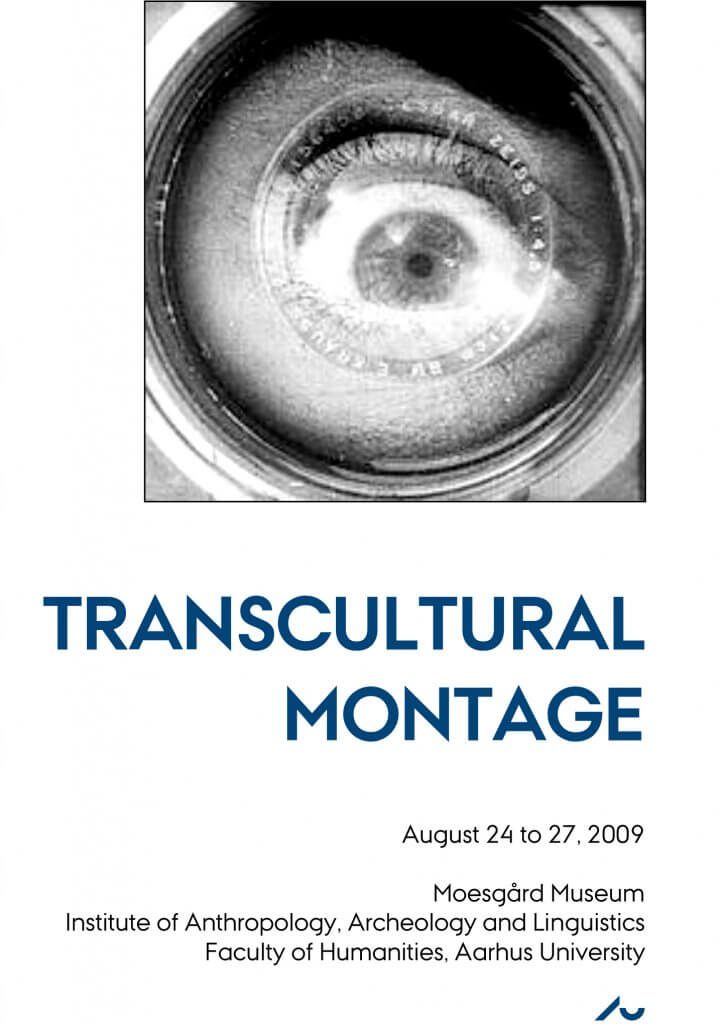 Transcultural Montage
Transcultural Montage
Aarhus University and Moesgaard Museum
Aarhus 24-27 August 2009
“I am kino-eye. I am a builder. I have placed you, whom I’ve created today, in an extraordinary room which did not exist until just now when I also created it.” (Dziga Vertov, 1923)
This conference focuses on the topic of montage and its possibilities and limitations for moving beyond realist forms of representation in anthropology. In its conventional usage, montage refers to the juxtaposition of shots in the production of film. However, in addition to ethnographic film, this conference also addresses the use of montage in other forms of anthropological communication, such as writing, exhibition making, photography, and video installation. The questions to be explored are the following:
• When and how do particular montage juxtapositions of images, sounds, objects, and words challenge and enhance our perception and bring us new revelations of the socio-cultural worlds we inhabit ?
• How may montage be applied to account for the invisible dimensions of human life, e.g., the invisible in vision, global economic forces, spiritual beings, and psychological conditions?
• What are the limitations of montage: which cuts and which kinds of montage work to reinforce rather than transcend stereotypes and commonsense perception?
• How can different anthropological media, such as film, writing, photography, sound and exhibition-making be combined through the principle of montage?
• How and in what ways can realist and radical constructivist forms of writing, film, and museum display be combined?
Ranging from polyphonic ethnography to non-linear evocative prose and abstract displacement of concepts, anthropological literature shows a rich tradition of experimentation with what may be characterized as cinematic forms of montage (Marcus 1994). A shared aim of these experiments was to upturn the authoritarian voice of the anthropological author along with its realist claim of offering a one-to-one correspondence between words and world. Similarly, disruptive montage installations or artistic collages have been used to break with the idea of museum display as a direct transmission of reality. In contrast to the display of objects as integrated parts of socio-cultural frameworks, or as props in the naturalist reconstruction of markets, homes, slums etc, the staging of artifacts in seemingly grotesque montage sceneries have aimed at creating verfremdung effects to induce a more reflexive stance towards the worlds produced in museum displays (cf. Gonseth et. al. 2002). Likewise, ethnographic filmmakers have experimented with the creation of kino-fists and montage shocks, but in keeping with the realist ideals of observational cinema, most ethnographic filmmakers nevertheless still regard montage as something that is best minimised (Vaughan 1992, Kiener 2008). Rather than the virtual space-time of montage, the long observational take, which preserves natural duration and imitates ordinary perception, is appreciated for its potential to return our gazes to the particularities of everyday life and the transcultural commonalities of being human. Despite the experiments with various representational forms, realism, along with its model of truth as correspondence, is still a dominating principle – not only in film, but also in anthropological writing and museum work.
But realism has shortcomings that remain unresolved – especially when dealing with aspects of human life that are invisible. Such aspects include, quite concretely, the backsides of the objects that we perceive (e.g. the invisible in vision), but also, on a broader scale, our entanglement in global cultural and socio-economic processes as well as the impact of invisible spiritual beings that for many are considered as being on the same level of reality as the visible. The super-real view of montage and the gaps created in the juxtapositions of shots may provide ways of approaching the impact of these invisible dimensions of human reality (Marcus 1994, Kiener 2008). An additional form of invisibility, which may be accounted for through montage, is that invisible face of the Other, which Levinas (1999) argues lies hidden beneath the facial expressions on the forefront of the head. According to Levinas, we may address the otherness of the Other only to the extent that we maintain a fundamental separation of self and Other. If we agree with this argument, it follows that the disruption and dislodging of our commonsense vision must be a precondition for getting a fee for the irreducible being of Others. The deconstructive potential of montage to disrupt our tendency for attributing sameness to difference may be an essential tool in this regard (cf. Strathern 1988).
But where does this lead us? Should the realist correspondence criteria that continue to operate as the validating principle in much anthropological writing, exhibition- and filmmaking be altogether abandoned? Does disruptive montage provide a satisfying alternative? Obviously, realist aesthetics can also be used in the service of disrupting our commonsense perception. Likewise, montage does not necessarily always disrupt our perception, but may equally well be used to reinforce stereotypical understandings of self and others. The question of how to retain a sense of coherence on the one hand while making use of the disruptive effects of montage on the other still appears pivotal and unresolved (Marcus 1994). An aim of this conference, therefore, is to consider the possibilities of combining realist and radical constructivist forms of representation in anthropology.
The conference has been made possibly by the generous support of the Danish Film Institute, Filmby Århus, The Humanities Graduate School (Aarhus University), Aarhus University Research Foundation, The Danish Research School of Anthropology and Ethnography, Department of Anthropology and Ethnography (Aarhus University), and Ethnographic Collections (Moesgård Museum). Furthermore, we are grateful for the assistance of Ton Otto, students at the Department of Anthropology (AU) and our colleagues at the Ethnographic Collections, Moesgård Museum.

